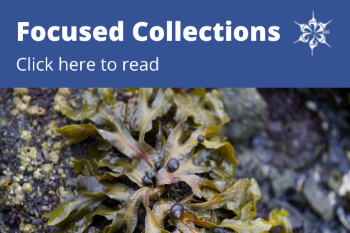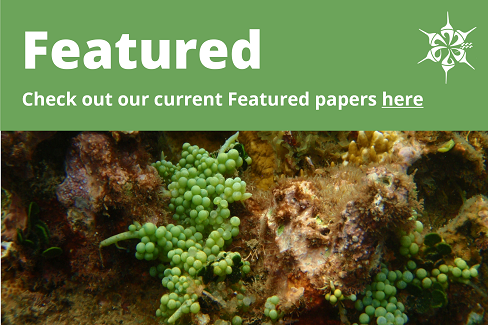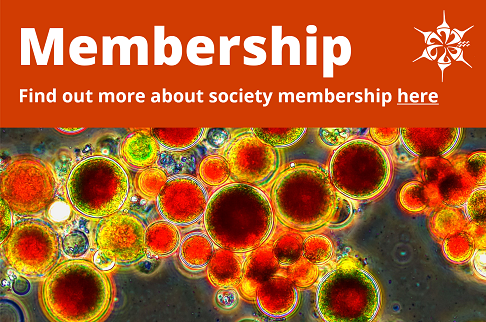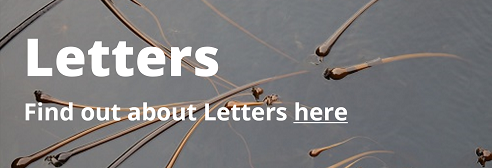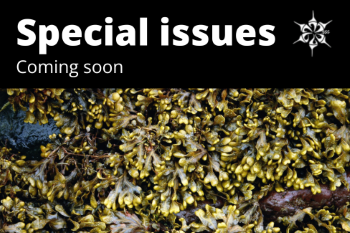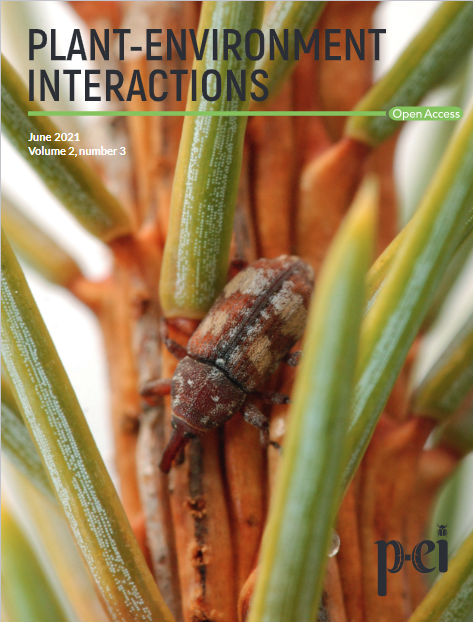Author Guidelines
The Journal of Phycology publishes all aspects of basic and applied research on algae to provide a common forum for the ecologist, physiologist, cell biologist, molecular biologist, evolutionary biologist, morphologist, taxonomist, geneticist, and biochemist, among others. Papers are accepted based on the original and meritorious data and ideas and the potential impact the research would have on the field. Manuscripts describing new techniques are also welcome; they should include results that illustrate the usefulness and application(s) of the technique. Reviews and minireviews are generally solicited, but interested authors are encouraged to contact the managing editor. Comments may be submitted that describe methods or equipment or that discuss papers previously published in the Journal. Manuscripts submitted must not have been published, accepted for publication, or be under consideration for publication elsewhere; nor should they contain substantial data that is published elsewhere (unless published in a master’s or doctoral thesis).
Please find the Wiley preprint policy here.
The Journal of Phycology will consider articles that have been submitted in part or in full to a preprint server, such as bioRxiv.
Please contact the editorial office if you have any questions regarding this ([email protected]).
Articles that had been submitted to other journals previously do not need to be formatted for the Journal of Phycology until after review.
Sections
1. Submission and Peer Review Process
Once the submission materials have been prepared in accordance with the Author Guidelines, manuscripts should be submitted online at https://mc.manuscriptcentral.com/jpy.
For help with submissions, please contact: [email protected].
The online submission is a step-by-step process for which full instructions are provided, with additional support available online. The use of ScholarOne Manuscripts facilitates the quick transfer of manuscripts among associate editors and reviewers.
The journal employs a plagiarism detection system. By submitting your manuscript to the Journal of Phycology, you accept that your manuscript will be screened against previously published works.
Authors must deposit data, strains, or other materials in scientific collections (e.g., culture collections, herbaria, GenBank, etc.) to make it possible to repeat the experiments and perform future research. The journal encourages authors to share the data and other artefacts supporting the results in the paper by archiving it in an appropriate public repository. Authors should include a data accessibility statement, including a link to the repository used, as this statement will be published alongside their paper. All molecular sequence data must be deposited in GenBank or other international databases.
This journal does not charge submission fees.
Policy for taxonomic papersAll manuscripts must follow the Journal of Phycology taxonomy guidelines linked here.
The Journal of Phycology’s policy is to avoid citing authorities of names in all papers, except when it is essential for taxonomic work, such as when describing new taxa or new combinations or where a discussion of nomenclatural priority is necessary. In cases where there is a disagreement over citing authority names, the decision of the Managing Editor is final.
- All holotypes of species or infraspecific taxa must be deposited in a recognized herbarium preferably with an accession number (not in a personal collection).
- For taxa above the rank of species a molecular phylogenetic analysis must be included demonstrating monophyly of the proposed new taxon and related sister taxa.
- New species or subspecific taxa must include at least one diagnostic DNA sequence with the GenBank accession number listed (data may be new or derive from existing GenBank records, but must be from the type collection) and must be illustrated with photograph(s) or line drawing(s), including diagnostic features, if present.
- Generally, descriptions of a single new species will not be considered for publication unless there is some aspect of the biology of the species or additional information that is significant and that highlights the importance of the species to phycologists.
Author contribution indication
The journal requires authors to complete contributor information in the Authors & Institutions section of the submission system. More information on the contributor types can be found here.
Protection of human subjects and animals in research
A statement indicating that the protocol and procedures employed were reviewed and approved by the appropriate institutional review committee must be included in the Materials and Methods section of the manuscript. When reporting experiments on human subjects, authors should indicate whether the procedures followed were in accordance with the ethical standards of the responsible committee on human experimentation (institutional and national) and with the Helsinki Declaration of 1975, as revised in 2008. When reporting experiments on animals, authors should indicate whether the institutional and national guide for the care and use of laboratory animals was followed. For research involving recombinant DNA, containment facilities and guidelines should conform to those of the National Institutes of Health or corresponding institutions. For those investigators who do not have formal ethics review committees, the principles outlined in the Helsinki Declaration should be followed. If doubt exists whether the research was conducted in accordance with the Helsinki Declaration, the authors must explain the rationale for their approach and demonstrate that the institutional review body explicitly approved the doubtful aspects of the study.
Conflict of interest disclosure
The Journal of Phycology requires all authors to disclose any potential sources of conflict of interest when directly relevant or directly related to the work that the authors describe in their manuscript. Any interest or relationship (financial or otherwise) that may be perceived as influencing an author's objectivity is considered a potential source of conflict of interest, including patent or stock ownership, membership of a company board of directors, membership of an advisory board or committee for a company, or consultancy for or receipt of speaker's fees from a company. The existence of a conflict of interest does not preclude publication in this journal.
If the authors have no conflict of interest to declare, they must also state this at submission. It is the responsibility of the corresponding author to review this policy with all authors and to list on the cover letter, in the manuscript (under the Acknowledgements section), and in the online submission system ALL pertinent commercial and other relationships.
The above policies are in accordance with the Uniform Requirements for Manuscripts Submitted to Biomedical Journals produced by the International Committee of Medical Journal Editors.
Article Preparation Support
Wiley Editing Services offers expert help with English Language Editing, as well as translation, manuscript formatting, figure illustration, figure formatting, and graphical abstract design – so you can submit your manuscript with confidence. Also, check out our resources for Preparing Your Article for general guidance about writing and preparing your manuscript.
Open Access
The Journal of Phycology is a subscription journal that offers an Open Access option. You’ll have the option to make your article open access after acceptance, which will be subject to an APC unless a waiver applies. Read more about APCs here.
Data Sharing and Data Availability
This journal encourages data sharing. Review Wiley’s Data Sharing policy where you will be able to see and select the data availability statement that is right for your submission.
Data Citation
Please review Wiley’s Data Citation policy.
Data Protection
By submitting a manuscript to or reviewing for this publication, your name, email address, and affiliation, and other contact details the publication might require, will be used for the regular operations of the publication. Please review Wiley’s Data Protection Policy to learn more.
Funding
You should list all funding sources in the Acknowledgments section. You are responsible for the accuracy of their funder designation. If in doubt, please check the Open Funder Registry for the correct nomenclature.
Authorship
All listed authors should have contributed to the manuscript substantially and have agreed to the final submitted version. Review editorial standards and scroll down for a description of authorship criteria.
Author Pronouns
Authors may now include their personal pronouns in the author bylines of their published articles and on Wiley Online Library. Authors will never be required to include their pronouns; it will always be optional for the author. Authors can include their pronouns in their manuscript upon submission and can add, edit, or remove their pronouns at any stage upon request. Submitting/corresponding authors should never add, edit, or remove a coauthor’s pronouns without that coauthor’s consent. Where post-publication changes to pronouns are required, these can be made without a correction notice to the paper, following Wiley’s Name Change Policy to protect the author’s privacy. Terms which fall outside of the scope of personal pronouns (e.g., proper or improper nouns), are currently not supported.
Reproduction of Copyright Material
If excerpts from copyrighted works owned by third parties are included, credit must be shown in the contribution. It is your responsibility to also obtain written permission for reproduction from the copyright owners. For more information visit Wiley’s Copyright Terms & Conditions FAQ.
The corresponding author is responsible for obtaining written permission to reproduce the material "in print and other media" from the publisher of the original source, and for supplying Wiley with that permission upon submission.
Title Page
The title page should contain:
-
A brief informative title containing the major key words. The title should not contain abbreviations (see Wiley's best practice SEO tips);
-
A short running title of less than 40 characters;
-
The full names of the authors;
-
The author's institutional affiliations where the work was conducted, with a footnote for the author’s present address if different from where the work was conducted;
-
Acknowledgments.
Main Text File
The main text file should be in Word format.
Reference Style
This journal uses APA reference style (7th edition). Review your reference style guidelines prior to submission.
Figures and Supporting Information
Figures, supporting information, and appendices should be supplied as separate files. You should review the basic figure requirements for manuscripts for peer review, as well as the more detailed post-acceptance figure requirements. View Wiley’s FAQs on supporting information.
Peer Review
This journal operates under a single-anonymized peer review model. Papers will only be sent to review if the Editor-in-Chief determines that the paper meets the appropriate quality and relevance requirements.
In-house submissions, i.e., papers authored by Editors or Editorial Board members of the title, will be sent to Editors unaffiliated with the author or institution and monitored carefully to ensure there is no peer review bias.
Wiley's policy on the confidentiality of the review process is available here.
Appeals and Complaints
Authors may appeal an editorial decision if they feel that the decision to reject was based on either a significant misunderstanding of a core aspect of the manuscript, a failure to understand how the manuscript advances the literature or concerns regarding the manuscript-handling process. Differences in opinion regarding the novelty or significance of the reported findings are not considered as grounds for appeal. To raise an appeal, please contact the journal by email, quoting your manuscript ID number and explaining your rationale for the appeal. The editor’s decision following an appeal consideration is final.
To raise a complaint regarding editorial staff, policy or process please contact the journal in the first instance. If you believe further support outside the journal’s management is necessary, please refer to Wiley’s Best Practice Guidelines on Research Integrity and Publishing Ethics.
Refer and Transfer Program
Wiley believes that no valuable research should go unshared. This journal participates in Wiley’s Refer & Transfer program. If your manuscript is not accepted, you may receive a recommendation to transfer your manuscript to another suitable Wiley journal, either through a referral from the journal’s editor or through our Transfer Desk Assistant.
Guidelines on Publishing and Research Ethics in Journal Articles
The journal requires that you include in the manuscript details IRB approvals, ethical treatment of human and animal research participants, and gathering of informed consent, as appropriate. You will be expected to declare all conflicts of interest, or none, on submission. Please review Wiley’s policies surrounding human studies, animal studies, clinical trial registration, biosecurity, and research reporting guidelines.
This journal follows the core practices of the Committee on Publication Ethics (COPE) and handles cases of research and publication misconduct accordingly (https://publicationethics.org/core-practices).
2. Article Types
Research Articles:
The following sequence should be used.
-
Title page—Provide a concise title, including class or division (phylum) designation when a genus or species name is included. Place a superscripted number one (1) after the last word of the self-archiving title to correspond to a footnote that will indicate the date of submission and acceptance. Use full name (including first name for aid in bibliographic work) of the author(s) and complete address with ZIP or postal code. Each author should be listed separately followed by his/her affiliation. Also indicate the author to contact regarding correspondence with a superscripted number two (2); include an e-mail address, phone, number for the corresponding author. Please ensure that the e-mail address is valid, as this will be the address used for communication about the submission and publication process. Include a condensed running title of no more than 35 letters and spaces.
-
Abstract—This should be a concise (no more than 250 words) summary of the investigation with objectives, results, and conclusions included. Please state the major scientific significance and implications of the conclusions, for the broader audience. Include scientific names of key organisms without authorities. New taxa described in the manuscript must be mentioned. Do not repeat information in the title or reference the literature. At the end of the Abstract, list 5 to 10 Key index words, then include a list of abbreviations. Each abbreviation should be followed by its meaning written out in full (e.g., GFP, green fluorescent protein). Common abbreviations (e.g., DNA) do not need to be included.
-
Introduction
-
Materials and Methods—Whenever possible (and appropriate), the authors should include the sources of reagents and software (company name, city, state, country when first referenced), the equipment with manufacturer and model number, strain or clone numbers, and latitudes/longitudes of study sites. Use metric units (Systéme International d’Unités, SI) and SI style (e.g., μmol photons ⋅ 1m–2 ⋅ s–1, g ⋅ L–1).
-
Results—Only the results of the study should be included. Include statistical analyses or other indicators to enable assessment of the variance of replicates of the experiments.
-
Discussion—Discuss the significant results and their importance to the study and to the discipline in general. Minimize repetition with other sections. The Results and Discussion sections may be combined, in which case a Conclusions section might be advantageous, although this section should be concise. Include your Author Contributions information at the end of this section.
-
Acknowledgments—The acknowledgments should be followed by your funding statement and ORCID details, if applicable.
-
References—After the reference list include the main table headings and figure captions, followed by the table headings and figure captions or other information for any supporting material.
Other article types
Research letters: Research Letters provide a platform for rapid publication of high impact work.
Manuscripts submitted as Research Letters must be concise and written for a broad readership. These will be subjected to strict scrutiny by a review panel. The review panel aims to decide whether to consider submitted Research Letters for peer-review within three business days, and if granted, the peer-review process should be completed no more than 21 days after receipt of the submission. If the submittal is rejected by the review panel, then the work may be resubmitted as a standard manuscript. Historically, less than 20% of submitted Research Letters are sent for peer-review. It is critical that authors pay special attention to the Scientific Contribution field during the submittal process.
Additionally, Letters should be less than 1500 words, include a short abstract of less than 150 words, followed by a methods paragraph, a results and discussion section(s) (but with no formal headings) and full references.
Letters may include two non-text items (i.e., tables and/or figures). Any other tables, figures, and/or methods should be provided as supplementary materials.
The following submission types all go through standard peer review. Note: pages ranges are for printed pages. Estimate three typed pages for every printed journal page.
|
Article Type |
Description |
Limits |
Abstract / Structure |
|
Research Notes |
Brief descriptions of findings that are of interest to the broader community but for which the work is preliminary but impactful |
1-3 journal pages |
Yes, structured |
|
Comments |
Brief articles that discuss papers previously published in the Journal |
1-3 journal pages |
Yes, unstructured |
|
Genome Resource |
Short data descriptor papers on genomes and/or transcriptomes of algae and cyanobacteria of interest to the broader phycological community |
2-5 journal pages |
Yes, structured |
|
Methods |
Brief papers that describe methods, databases, and other tools of use to the phycological community |
3–8 journal pages |
Yes, structured |
|
Mini Reviews |
Short reviews on a topic of interest for a broad audience |
3–8 journal pages |
Yes, structured |
|
Reviews |
Longer reviews that summarize key aspects of a discipline |
up to 20 journal pages |
Yes, structured |
Further Details
Research notes: brief descriptions of findings that are of interest to the broader community but for which the work is preliminary but impactful.
- 1–3 journal pages
- Same general format as research articles (without headings except for abstract)
Comments: brief articles that discuss papers previously published in the Journal.
- 1-3 journal pages
- Written in commentary style
- Have only one level of headings (i.e., no subheadings)
Genome Resource: short data descriptor papers on genomes and/or transcriptomes of algae and cyanobacteria of interest to the broader phycological community.
- 2-5 journal pages
- Brief introduction including relevance
- Methods (include: sequencing and bioinformatic methods; collection information regarding the organism(s) (e.g. field collections, culture collections, herbaria); and deposit information for the genome(s)
- Three figures (circular genome diagrams should be included in the supplementary data)
- Brief combined results and discussion
- Link to the GenBank accession number in the abstract
Methods: brief papers that describe methods, databases, and other tools of use to the phycological community.
- 3–8 journal pages
- Have only one level of headings (i.e., no subheadings)
- Include a brief abstract
Mini Reviews: short reviews on a topic of interest for a broad audience.
- 3–8 journal pages
- Written in commentary style
- Have only one level of headings (i.e., no subheadings)
- Include a brief abstract
Reviews: longer reviews that summarize key aspects of a discipline.
- Up to 20 journal pages
- Can include several levels of headings
3. After Acceptance
General formatting
References: In-text citations and reference lists should follow APA (7th edition) formatting.
Tables: Any tables should be created using the Table function in Word. Each table must be numbered with Arabic numerals (e.g., Table 2), given a descriptive title placed at the top of the table, and saved as its own file. The title and table contents must be double-spaced and in 12-point font. Footnotes should be kept to a minimum and indicated in the table by superscripted letters (a, b, c) rather than symbols or numbers. As vertical lines cannot be typeset, a table that uses vertical lines will be considered a figure. Complex tables will be typeset at the author’s expense unless they are submitted as a camera-ready figure that can be treated as a line drawing.
Figures: For final submission of a manuscript, any figures must be in digital format. Each figure must be a separate EPS, PDF, or TIFF file with a resolution of 300 dpi or higher.
-
Drawings, graphs—The labels for line drawings must be large enough to be read easily after reduction; many line drawings are reduced to one-column width. Use the reducing function on a photocopy machine to check that the labeling is of sufficient size. The outer line on bars or boxes should be adequately sized for reduction (at least 1-point font). All species names should be italicized within the figure and for drawings, a scale indicator (e.g., a line representing specific distance) is required. Do not use two shades of gray in histograms. Line art will be reproduced from electronic files. Axis labels should be of uniform font and size and should not be bold. Use an initial capital letter for the first word of each label (e.g., Relative carbon content). If units are included in the label, use the SI style with a middot/dot operator when necessary (e.g., μg × L–1). Numerals should include a comma to separate groups of three digits (e.g., 1,200).
-
Photographs—Individual photographs used to generate a plate should be of equal contrast to help produce a high-quality composite print. Each photograph must contain a scale measure, be squared accurately, and be separated from other photographs in the by thin white lines. Scale length may be indicated directly above the scale or in the legend.
-
Legends—Figure legends must be typed double-spaced in paragraph form and included after the Tables in the main manuscript. Do not repeat details that are already in the text but provide enough information to make it easy to comprehend the meaning of the meaning of the figure.
-
Cite each figure and table in the text in order of the presentation (e.g., Figure 1 before Figure 2, Table 9 before Table 10).
-
Each component (panel) of a composite figure should be labeled with lowercase letters (e.g., a, b, c) and not with numbers or uppercase letters.
Additionally, try to ensure the table content descriptions and figure legends are as descriptive as possible so that that if the image or table cannot be viewed for some reason, a reader will still have an idea of the content of the image/table. You, however, do not need to repeat any information that is in the main manuscript wherein you cite the figure.
Abbreviations: All terms, abbreviations, and symbols should correspond to those used in the text of the paper. It is preferable to include a symbol key directly within the line drawings. Abbreviated gene names should be italicized except for the subunit (e.g., rbcL); however, rRNA genes should remain unitalicized. If using SSU or LSU rRNA gene, please note whether these genes are from the nucleus, chloroplast, or mitochondria.
Wiley will host online supplementary material submitted by the authors. Supplementary material must be important, ancillary information relevant to the article that does not or cannot appear in the printed edition of the journal. Each piece of supplementary material should be submitted as a separate file, without a title/caption. Tables, figures, or data appendices should be numbered with an “S” (e.g., Table S1, Table S2 etc.; Figure S1, Figure S2, etc.; Appendix S1, Appendix S2, etc.). Include captions/titles for supplementary materials in the main document following any figure captions. The editorial office may suggest that figures or tables be moved to supplementary materials. Citations that pertain only to supplementary materials should appear as part of the supplementary file only.
Wiley Author Services
When an accepted article is received by Wiley’s production team, the corresponding author will receive an email asking them to login or register with Wiley Author Services. You will be asked to sign a publication license at this point as well as pay for any applicable APCs.
Copyright & Licensing
Hybrid Open Access
You may choose to publish under the terms of the journal’s standard copyright agreement, or Open Access under the terms of a Creative Commons License.
Standard re-use and licensing rights vary by journal. Note that certain funders mandate a particular type of CC license be used. This journal uses the CC-BY Creative Commons License.
Self-Archiving Definitions and Policies: Note that the journal’s standard copyright agreement allows for self-archiving of different versions of the article under specific conditions.
Please contact the managing editor for permission to reproduce any portion of an article that has been published in the journal that is not under a CC license as copyright is held by the Phycological Society of America. For articles published Open Access under a CC license, copyright remains with the authors, and permission to reprint is not required.
Early View
Upon publication, articles are available as full text HTML or PDF in Early View prior to inclusion in an issue and can be cited as references using their Digital Object Identifier (DOI) number.
Article Promotion Support
Wiley Editing Services offers professional video, design, and writing services to create shareable video abstracts, infographics, conference posters, lay summaries, and research news stories for your research – so you can help your research get the attention it deserves.
Author Name Change Policy
In cases where authors wish to change their name following publication, Wiley will update and republish the paper and redeliver the updated metadata to indexing services. Our editorial and production teams will use discretion in recognizing that name changes may be of a sensitive and private nature for various reasons including (but not limited to) alignment with gender identity, or as a result of marriage, divorce, or religious conversion. Accordingly, to protect the author’s privacy, we will not publish a correction notice to the paper, and we will not notify co-authors of the change. Authors should contact the journal’s Editorial Office with their name change request.
Correction to Authorship
In accordance with Wiley’s Best Practice Guidelines on Research Integrity and Publishing Ethics and the Committee on Publication Ethics’ guidance, the Journal of Phycology will allow authors to correct authorship on a submitted, accepted, or published article if a valid reason exists to do so. All authors – including those to be added or removed – must agree to any proposed change. To request a change to the author list, please complete the Request for Changes to a Journal Article Author List Form and contact either the journal’s editorial or production office, depending on the status of the article. Authorship changes will not be considered without a fully completed Author Change form. [Correcting the authorship is different from changing an author’s name; the relevant policy for that can be found in Wiley’s Best Practice Guidelines under “Author name changes after publication.”]





